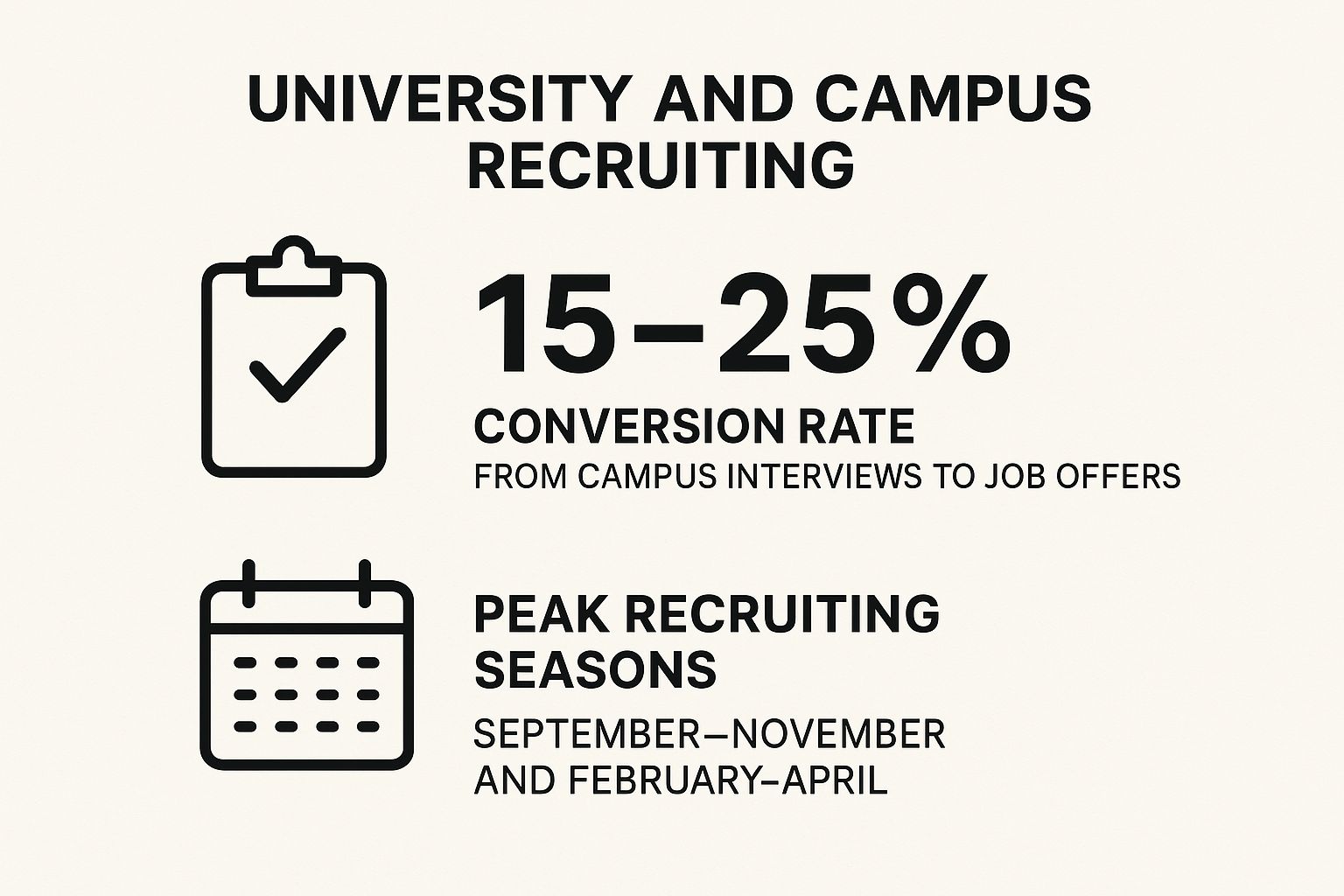August 1, 2025
10 Candidate sourcing strategies You Should Know

Finding top talent requires more than just posting a job and waiting for applications to roll in. A proactive and multi-faceted approach is essential for building a robust talent pipeline and securing the best candidates before your competitors do. The difference between a good hire and a great one often comes down to the quality and diversity of your candidate sourcing strategies. This guide moves beyond the basics, offering a comprehensive roundup of ten proven methods that modern recruiters can implement immediately. You won't find generic advice here; instead, we provide actionable steps, practical examples, and fresh perspectives for each strategy.
Whether you're looking to master advanced Boolean search strings, build a powerful employee referral program, or leverage AI for smarter matching, this article has you covered. We'll explore how to effectively engage passive candidates, tap into university talent pools, and use competitive intelligence to map out the talent market. Each section is designed to be a practical playbook, helping you not only find qualified individuals but also attract those who are the right fit for your organization's culture and long-term goals. Prepare to refine your approach and discover new, effective ways to connect with the professionals you need to hire.
1. Boolean Search Technique
Boolean search is a foundational component of modern candidate sourcing strategies. It leverages a specific syntax using operators like AND, OR, and NOT to create highly precise search queries. This method transforms broad platforms like Google, LinkedIn, and internal applicant tracking systems into powerful tools for pinpointing ideal candidates who might not be actively looking for a new role. By combining keywords, job titles, skills, and locations, recruiters can systematically filter through massive talent pools to uncover hidden gems.

This technique is essential for moving beyond simple keyword searches and gaining a competitive edge, especially for hard-to-fill technical or niche roles.
How to Implement Boolean Search
Mastering Boolean search involves understanding its core operators and how to combine them effectively.
- AND: Narrows results by requiring all specified terms to be present. For example,
Software Engineer AND Python AND "data science"will only show profiles containing all three elements. - OR: Broadens results by including profiles that contain at least one of the specified terms. This is perfect for synonyms, like
(VP OR "Vice President") AND Sales. - NOT: Excludes specific terms to refine your search. For example,
Java Developer NOT recruiterfilters out profiles of talent acquisition professionals. - Parentheses (): Group terms together to create more complex search strings.
(Java OR Python) AND developer AND (SF OR "San Francisco")finds developers skilled in either language located in San Francisco. - Quotation Marks "": Searches for an exact phrase.
"Product Marketing Manager"will return results with that specific title, not just the individual words.
2. Social Media Recruiting
Social media recruiting is a modern sourcing strategy that leverages platforms like LinkedIn, Twitter, and even Instagram to identify, engage, and attract potential candidates. This approach transforms these networks from simple social spaces into dynamic talent pools. It allows recruiters to move beyond traditional job boards, build authentic relationships, showcase company culture, and tap into vast networks of passive candidates who may not be actively seeking new opportunities.

This method is crucial for building a strong employer brand and engaging talent in a more personal and direct way. For example, companies like HubSpot use LinkedIn to highlight employee achievements, while Shopify uses Instagram to showcase a vibrant and diverse workplace, making them attractive to top professionals.
How to Implement Social Media Recruiting
Effective social media recruiting goes beyond just posting job openings. It's about building a community and providing value.
- Maintain Brand Consistency: Ensure your company's voice, values, and visual identity are consistent across all social platforms to build a recognizable and professional employer brand.
- Engage Authentically: Avoid generic, automated messages. Personalize your outreach and participate in relevant industry conversations to build genuine connections with potential candidates.
- Share Valuable Content: Post industry insights, employee success stories, and behind-the-scenes content. This positions your company as a thought leader and a great place to work, attracting followers who could become future hires.
- Leverage Platform Tools: Utilize features like LinkedIn InMail for direct outreach, Twitter's advanced search to find people discussing specific skills, and Facebook Groups to connect with niche communities.
- Track Your Metrics: Monitor engagement rates, follower growth, and click-through rates on job links. Use this data to refine your strategy and focus your efforts on the platforms that deliver the best results.
3. Employee Referral Programs
Employee referral programs are a highly effective candidate sourcing strategy that formalizes word-of-mouth recruitment. This structured approach incentivizes current employees to recommend qualified candidates from their professional and personal networks. It leverages the unique insight your team has into the company culture and specific role requirements, leading to high-quality candidates who are often a better fit and tend to stay longer. This method transforms your entire workforce into a powerful, trusted sourcing channel.

Tapping into your employees' networks is one of the most reliable candidate sourcing strategies, often yielding candidates with higher retention rates and faster onboarding times. Success stories like Google's program, which contributes to a significant portion of their hires, demonstrate the immense potential of this approach.
How to Implement an Employee Referral Program
A successful referral program is built on clarity, simplicity, and meaningful incentives.
- Offer Competitive Incentives: Design a reward structure that motivates employees. This can include tiered cash bonuses, extra vacation days, or exclusive company perks. For example, Accenture’s 'Refer a Star' program uses tiered rewards to great effect.
- Simplify the Process: Make submitting a referral as easy as possible. Use a simple form or a dedicated platform like Jobvite to remove friction. The easier it is, the more likely employees are to participate.
- Provide Clear Information: Arm your employees with detailed job descriptions and clear profiles of the ideal candidate. This helps them identify the most suitable contacts in their network.
- Communicate and Recognize: Keep the referring employee updated on their candidate's progress. Regularly communicate program successes and publicly recognize employees for their contributions, even if their referral isn't hired. This maintains engagement and shows appreciation.
4. Talent Pipeline Development
Talent pipeline development is a proactive, long-term approach to candidate sourcing strategies. Instead of scrambling when a position opens, this method involves continuously identifying, engaging, and nurturing relationships with potential candidates. This creates a ready-to-tap pool of qualified, pre-vetted talent, significantly reducing time-to-hire and improving the quality of placements for future roles. It shifts recruiting from a reactive to a strategic function.
This strategy is particularly effective for roles with high turnover or predictable future demand, such as sales or engineering. Companies like Amazon and Microsoft excel at this, maintaining dedicated pipelines for specialized technical talent and diversity hiring initiatives, ensuring they always have access to top-tier candidates.
How to Implement Talent Pipeline Development
Building a robust talent pipeline requires consistent effort and a focus on relationship management.
- Identify Future Needs: Proactively work with department heads to forecast future hiring needs and identify key roles that will require a steady stream of candidates.
- Use a CRM: Employ a Candidate Relationship Management (CRM) system to track interactions, log preferences, and segment your talent pool based on skills, experience, and engagement level.
- Provide Consistent Value: Nurture relationships by sharing valuable content like industry news, company updates, or career development advice. This keeps your company top-of-mind without constant job-pushing.
- Segment Your Pipeline: Divide your talent pool into groups, such as active job seekers, passive candidates interested in future roles, and "silver medalists" who were strong contenders for previous positions.
- Maintain Regular Contact: Schedule periodic check-ins to maintain a warm connection. A simple "hello" or an update on a relevant company project can keep the relationship active.
5. AI-Powered Candidate Matching
AI-powered candidate matching is one of the most transformative candidate sourcing strategies, leveraging artificial intelligence to automate and enhance the identification of top talent. This technology analyzes résumés, online profiles, and past applicant data against job requirements to predict which candidates are the best fit. By processing vast datasets, AI tools can identify patterns and predict success probability, moving beyond simple keyword matching to assess skills, experience, and even potential cultural alignment with incredible speed and accuracy.
This method helps talent acquisition teams sift through high volumes of applicants efficiently, reduce hiring time, and uncover qualified candidates who might have been overlooked by traditional screening. For instance, Hilton used AI to slash its time-to-hire by five days, showcasing the technology's impact on sourcing efficiency.
How to Implement AI-Powered Candidate Matching
Integrating AI into your sourcing workflow requires a strategic approach to maximize its benefits while maintaining fairness and human oversight.
- Start with High-Volume Roles: Begin by applying AI matching to positions where you receive a large number of applicants. This allows you to see the most significant return on investment by automating the initial screening process.
- Audit for Bias: Regularly audit the AI's algorithms and their outputs to ensure they are not perpetuating biases. Work with your vendor to understand how the tool makes decisions and ensure the training data is diverse and representative.
- Combine AI with Human Judgment: Use AI as a powerful shortlisting tool, not a final decision-maker. The best results come from combining the data-driven insights of AI with the nuanced understanding and intuition of experienced recruiters.
- Integrate and Measure: Ensure your AI platform integrates smoothly with your existing Applicant Tracking System (ATS). Continuously track key performance metrics like time-to-fill, quality of hire, and candidate diversity to measure impact. For a deeper dive, explore more about AI for talent acquisition at klearskill.com.
6. University and Campus Recruiting
University and campus recruiting is a targeted sourcing strategy focused on building relationships with educational institutions to identify emerging talent. This approach involves establishing partnerships with universities, attending career fairs, hosting information sessions, and creating internship programs. It is a proactive method for building a strong pipeline of entry-level and early-career candidates, ensuring a consistent influx of fresh perspectives and skills into your organization.
This strategy is particularly effective for filling roles in engineering, finance, and consulting, as demonstrated by the long-standing programs at companies like General Electric, Goldman Sachs, and McKinsey & Company. By engaging with students before they graduate, you build brand loyalty and gain a competitive advantage in securing top talent.
The infographic below highlights key timing and success metrics associated with campus recruiting efforts.

These statistics underscore the importance of aligning your recruiting activities with the academic calendar and demonstrate the high potential for converting on-campus interviews into successful hires.
How to Implement University and Campus Recruiting
Successfully launching a campus recruiting program requires a structured, relationship-focused approach.
- Build Authentic Relationships: Connect with university career services departments, professors, and student organizations. Go beyond simply showing up for a career fair; offer to host workshops or guest lecture in a relevant class.
- Offer Meaningful Internships: Design internship programs that provide real-world experience, mentorship, and a clear path to potential full-time employment. Avoid assigning interns menial tasks that don't contribute to their development.
- Leverage Recent Graduates: Use your current employees who are alumni of target universities as brand ambassadors. Their firsthand experience is relatable and can be highly persuasive for prospective candidates.
- Plan Multiple Touchpoints: Engage with students throughout the academic year. A consistent presence through information sessions, hackathons, and virtual events keeps your company top-of-mind.
- Define Clear Career Paths: Show new graduates what their career progression could look like within your company. A clear roadmap for growth and development is a powerful incentive for ambitious early-career talent.
7. Passive Candidate Outreach
Passive candidate outreach is a proactive sourcing strategy focused on identifying and engaging high-performing professionals who are not actively seeking new employment. This approach requires recruiters to act more like strategic marketers, researching individuals at target companies, building relationships, and nurturing them over time. Instead of waiting for applications, this method expands the talent pool to include the top 70% of the workforce that is currently employed and not job hunting, giving you access to proven talent.
This strategy is particularly effective for filling senior-level, niche, or highly competitive roles where the ideal candidates are unlikely to be found on job boards. It's a long-term play that builds a robust talent pipeline for future needs.
How to Implement Passive Candidate Outreach
Effective outreach hinges on personalization, patience, and providing value. It's about building a connection before making an ask.
- Research Thoroughly: Before making contact, understand the candidate’s career achievements, skills, and potential interests. Review their LinkedIn profile, personal portfolio, or any public work to inform your approach.
- Lead with Value: Your initial message should focus on them, not just your job opening. Mention a specific project they worked on or an accomplishment you admire. Offer value, like an interesting industry article or an invitation to a relevant webinar.
- Utilize Warm Introductions: Whenever possible, get introduced through a mutual connection. A referral significantly increases the likelihood of a response and establishes immediate credibility.
- Be Patient and Persistent: Passive candidates aren't on your timeline. It may take multiple, well-spaced touchpoints to build enough trust for a conversation. Always remain respectful of their time and preferences.
- Maintain the Relationship: Even if the timing isn't right, keep the connection warm. A candidate who isn't interested today might be the perfect fit in six months or could refer another great professional. This approach is key to improving your overall recruitment process. To explore this further, you can learn more about how to improve the recruitment process on klearskill.com.
8. Industry Networking and Events
Industry networking is a relationship-focused sourcing strategy that leverages professional events, conferences, and meetups to connect with candidates in person. This approach shifts the focus from transactional recruiting to building genuine professional relationships within specific industries. By engaging directly with talent at these gatherings, recruiters can identify high-quality candidates, build a strong employer brand, and create a pipeline for both immediate and future hiring needs through face-to-face interactions.
This hands-on method is one of the most effective candidate sourcing strategies for accessing passive talent that is highly engaged in their professional community. For instance, Atlassian builds its talent pipeline by maintaining a strong presence at developer conferences like KubeCon, while Salesforce engages its Trailblazer Community events to recruit certified professionals.
How to Implement Industry Networking and Events
Successfully leveraging events requires a strategic, community-first approach rather than an aggressive sales pitch.
- Choose Strategically: Select events where your ideal candidates are attendees, not just other recruiters. Focus on niche conferences, workshops, or local meetups relevant to the roles you need to fill.
- Give First: Instead of just collecting resumes, focus on providing value. Offer to review portfolios, share career advice, or simply have authentic conversations about industry trends. Sponsoring a coffee break or speaking on a panel can significantly increase visibility.
- Prompt Follow-up: The real work begins after the event. Connect with new contacts on LinkedIn within 24-48 hours, referencing your conversation to personalize the request. Nurture these connections over time.
- Track Relationships: Use your CRM or ATS to track interactions and the long-term hiring outcomes from your networking efforts. This helps demonstrate the ROI of attending events.
9. Content Marketing for Talent Attraction
Content marketing for talent attraction is a strategic approach that shifts the focus from actively hunting candidates to drawing them in organically. This method involves creating and distributing valuable, relevant content that showcases company culture, industry expertise, and career opportunities. By developing blogs, videos, and social media posts, you position your organization as an employer of choice, attracting candidates who are aligned with your values and mission before they even see a job posting.
This inbound methodology is one of the most effective long-term candidate sourcing strategies for building a sustainable talent pipeline. It works by establishing trust and authority, making your company a magnet for top professionals who resonate with your brand and vision.
How to Implement Content Marketing for Talent Attraction
Successfully attracting candidates with content requires a thoughtful, consistent plan that provides genuine value.
- Feature Real Employee Stories: Move beyond generic corporate messaging. Create blog posts or short videos where current employees share their experiences, career growth, and what they love about their work. HubSpot’s careers blog is a great example of this.
- Showcase Technical Expertise: For hard-to-fill technical roles, an engineering or data science blog can be incredibly effective. Share challenges your teams are solving and the technologies they use, as Spotify does with its engineering blog.
- Address Candidate Questions: Create content that answers the common questions and concerns candidates have. This could include posts about your interview process, compensation philosophy, or remote work policies.
- Optimize for Search (SEO): Use keyword research to ensure your content appears when candidates search for terms related to your industry and open roles. This makes your valuable content discoverable.
- Repurpose and Distribute: Turn a single blog post into multiple social media updates, an infographic, or a short video. Share your content across channels like LinkedIn, Twitter, and industry-specific forums to maximize its reach. You can discover additional guidance and recruitment best practices on klearskill.com.
10. Competitive Intelligence and Talent Mapping
Competitive intelligence and talent mapping are research-intensive candidate sourcing strategies focused on systematically analyzing competitor organizations. This proactive method involves identifying key talent, understanding team structures, and mapping the competitive landscape. By gathering intelligence on rival companies, recruiters can build a pipeline of high-value, passive candidates and gain a significant strategic advantage in the hiring process.
This approach is particularly powerful for executive search, scaling specialized teams, or entering new markets where top talent is concentrated within a few key companies. It transforms recruiting from a reactive function into a strategic business intelligence operation.
How to Implement Competitive Intelligence and Talent Mapping
Effective implementation requires a methodical approach to research and analysis, turning raw data into actionable hiring insights.
- Identify Target Companies: Begin by listing direct and indirect competitors, as well as aspirational companies known for their strong talent in your required skill areas.
- Map Organizational Structures: Use LinkedIn, company websites, and industry reports to chart out the hierarchy and team structures of target organizations. Focus on identifying key decision-makers, top performers, and entire teams relevant to your hiring needs.
- Gather Talent Data: Systematically collect information on individuals in key roles. Note their skills, experience, career progression, and public contributions like articles or conference talks. This creates a rich database for future outreach.
- Analyze and Act: Use the compiled intelligence to inform your sourcing strategy. You can approach individuals with highly personalized messages, understand what might motivate them to leave, and even predict potential talent movement in the market.
- Maintain Ethical Boundaries: Always rely on publicly available information (OSINT - Open-Source Intelligence) and maintain strict ethical standards. The goal is strategic insight, not corporate espionage.
Top 10 Candidate Sourcing Strategies Comparison
Final Thoughts
Navigating the modern talent landscape requires more than just posting a job and waiting for applications. As we've explored, a proactive, multi-channel approach is essential for attracting and engaging the high-caliber candidates who will drive your organization forward. The journey from a reactive recruiter to a strategic talent advisor begins with mastering a diverse toolkit of candidate sourcing strategies.
From the precision of Boolean search and the targeted engagement of social media recruiting to the long-term value of building a robust talent pipeline, each strategy offers a unique pathway to connect with potential hires. The key is not to implement just one or two of these methods, but to build a cohesive, integrated sourcing engine that works in concert. Your employee referral program can be supercharged with insights from competitive talent mapping, just as your campus recruiting efforts can be enhanced by a strong content marketing presence that showcases your employer brand.
Key Takeaways for Your Sourcing Toolkit
To truly elevate your recruitment efforts, remember these core principles:
- Diversification is Your Best Defense: Over-reliance on a single channel, like job boards, leaves you vulnerable to market shifts and talent shortages. A blended strategy, combining inbound tactics like content marketing with outbound efforts like passive candidate outreach, ensures a consistent flow of qualified individuals.
- Technology as an Enabler, Not a Replacement: AI-powered tools and advanced search techniques are powerful allies. They automate repetitive tasks, uncover hidden talent pools, and provide data-driven insights. However, they are most effective when they augment, rather than replace, the human element of building relationships and assessing cultural fit.
- The Long-Term View Wins: Sourcing isn't just about filling today's open roles. It's about building relationships that will pay dividends for months and years to come. Investing in talent pipelines, nurturing passive candidates, and maintaining a strong presence at industry events are strategic investments in your company's future success.
Your Actionable Next Steps
Mastering these candidate sourcing strategies is an ongoing process of learning, testing, and refining. Begin by auditing your current sourcing mix. Identify which channels are performing well and which are falling short. Then, select one or two new strategies from this guide to pilot over the next quarter. Measure your results, gather feedback, and continuously adapt your approach based on what the data and your experience tell you.
Ultimately, effective sourcing is the cornerstone of building a world-class team. By moving beyond traditional methods and embracing a more dynamic and strategic mindset, you position your organization not just to compete for talent, but to become a true talent magnet.
Ready to supercharge your sourcing and build a more effective, unbiased hiring process? Klearskill provides the tools you need to assess candidates based on real-world skills, helping you identify top performers from any source. Discover how our skills-based assessments can integrate seamlessly with your candidate sourcing strategies by visiting Klearskill today.
